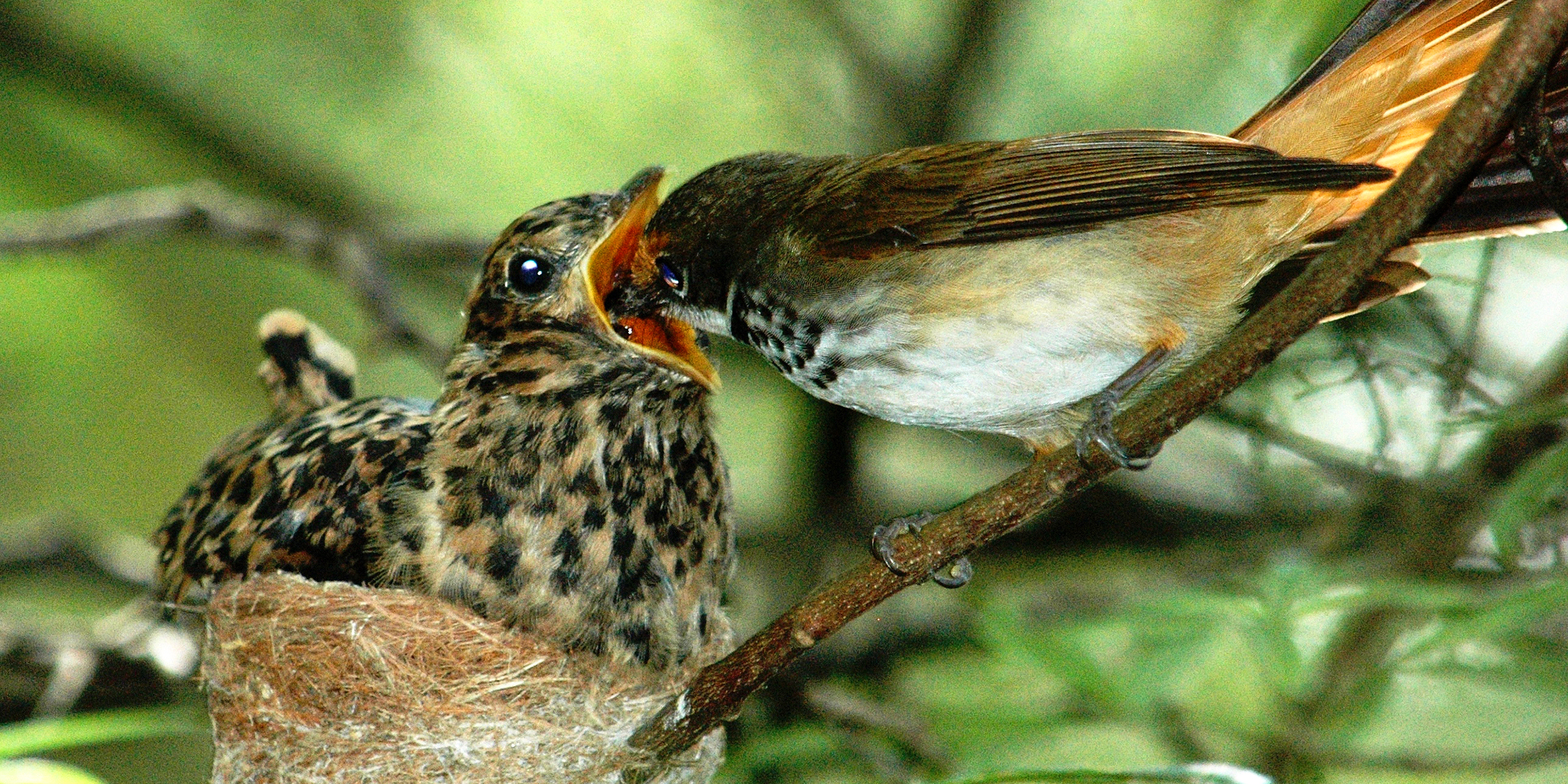Originally published 18 February 1991
Consider the cuckoo.
When the female cuckoo is ready to lay, she seeks a bird of another species that is building a nest — a reed warbler, say. The cuckoo perches on a nearby branch and waits. When the nest is finished, the reed warbler lays a clutch of eggs, at dawn. Sometime during early afternoon, when the male and female warblers are away foraging for food, the cuckoo glides onto the nest and lays one egg, identical in color and pattern to the reed warbler eggs, though somewhat larger. She takes one warbler egg in her beak and flies away, the whole operation having taken less than 10 seconds.
The cuckoo eats the stolen egg for lunch.
The warblers return to the nest and sit on the eggs, until the cuckoo egg, which incubates quickest, hatches. Out pops a chick, and the first thing it does, even before its eyes are open, is toss the other eggs — the authentic reed warbler eggs — out of the nest.
The warblers are perhaps a bit baffled by the missing eggs, but nevertheless they rear the changeling chick, thinking it their own. Soon the cuckoo has grown much larger (and eight times heavier!) than its tiny surrogate parents. The warblers continue to stuff the cuckoo’s gaping mouth with bugs and caterpillars.
It is nature’s ultimate scam, and for the cuckoo the last word in low-cost, no-bother parenting.
Britain’s bamboozled birds
In Britain, where the cuckoo’s call is a much-loved feature of the landscape, four species of birds are victimized — reed warblers, meadow pipits, dunnocks, and pied wagtails, all of them much smaller than the cuckoo. There seem to be four genetically distinct strains of female cuckoos, each specializing in one host species. Except for the cuckoo that lays her egg in the dunnock’s nest, each female’s egg closely resembles the eggs of the selected host.
Enter, the cuckoo-ologists.
Nicholas Davies and Michael Brooke are two Cambridge University ornithologists who specialize in cuckoos. They have described their work in the January [1991] issue of Scientific American. You’d have to be a little cuckoo to do what these guys do, but their research elegantly demonstrates the power of evolutionary theory to explain natural curiosities.
And the behaviors of cuckoos and their bamboozled hosts offer natural curiosities aplenty.
Davies and Brooke armed themselves with phony cuckoo eggs, made of resin, the exact size and weight of real cuckoo eggs, and painted to resemble the different eggs laid by the four strains of female cuckoos. Then they played cuckoo. They snitched real eggs from reed warbler nests and replaced them with phony cuckoo eggs. The warblers accepted eggs that resembled their own and rejected most of the others, pushing them out of the nests.
Clearly, reed warblers aren’t without some powers of discrimination, and natural selection would favor a cuckoo egg that closely resembles the host’s. The cuckoo eggs evolved accordingly, a classic example of mimicry in nature.
Surreptitious switches
This was just the beginning. Davies and Brooke systematically replaced eggs in the nests of all four species of host birds, with phony eggs of every type, at different times of the day, removing different numbers of host eggs, and every other combination of thieving and confounding they could think of. They even went to Iceland to try their surreptitious switches on meadow pipits and wagtails that have long lived in isolation from cuckoos.
Every response of the cuckoos and their hosts to phony eggs was consistent with natural selection. For example, Icelandic birds were more easily fooled by phony eggs than their British cousins; they have not needed to evolve defenses against cuckoo trickery. And the cuckoo that lays its eggs in the dunnock’s nest has no need of egg mimicry; the dunnock accepts almost any egg as its own, regardless of color or pattern, perhaps because it has only recently been parasitized by cuckoos.
What we have here appears to be a true case of co-evolution: Cuckoos have responded to the host’s defenses by evolving eggs that closely resemble host eggs. Hosts, in turn, have adapted to cuckoo parasitism by becoming ever more discriminating and less likely to be fooled.
According to Davies and Brooke, the result of all this knavish behavior on the part of cuckoos has been an evolutionary “arm’s race” between cuckoos and their hosts, leading to ever more intricate adaptions and counter-adaptations.
The most delightful thing of all about this story is the thought of the two cuckoo-ologists, their pockets full of phony cuckoo eggs, skulking around in marsh and moor trying to unravel the ways of evolution. Such behavior on the part of humans is surely a natural curiosity as worthy of investigation as the egg-laying habits of cuckoos, but possibly rather more resistant to explanation by natural selection.



